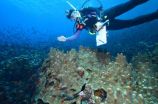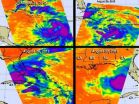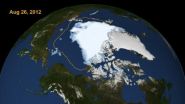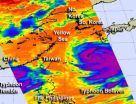(Press-News.org) Each year as many as 40,500 critically ill U.S. hospital patients die with an unknown medical condition that may have caused or contributed to their death, Johns Hopkins patient safety experts report in a recent study.
In a discussion of their findings, described online in BMJ Quality & Safety, researchers say that although diagnostic errors in the intensive care unit (ICU) may claim as many lives each year as breast cancer, they remain an underappreciated cause of preventable patient harm.
"Our study shows that misdiagnosis is alarmingly common in the acute care setting," says Bradford Winters, M.D., Ph.D., lead author and associate professor of anesthesiology and critical care medicine and neurology and surgery in the Johns Hopkins University School of Medicine. "To date, there's been very little research to determine root causes or effective interventions," Winters says, noting that less lethal patient safety risks have received greater attention.
By reviewing studies that used autopsy to detect diagnostic errors in adult ICU patients, the experts in the Johns Hopkins Armstrong Institute for Patient Safety and Quality discovered that 28 percent of patients — more than one in four — had at least one missed diagnosis at death. In 8 percent of patients, the diagnostic error was serious enough that it may either have caused or directly contributed to the individual's death and, if known, likely would have changed treatment, researchers say. Infections and vascular maladies, such as heart attack and stroke, accounted for more than three-quarters of those fatal flaws.
Overall, the medical conditions most commonly missed by diagnosticians included heart attack; pulmonary embolism, an artery blockage in the lungs; pneumonia; and aspergillosis, a fungal infection that most commonly affects individuals with a weakened immune system. Cumulatively, these four conditions accounted for about one-third of all illnesses that doctors failed to detect.
Their review of 31 studies included 5,863 autopsies from a wide range of ICU types. The prevalence of autopsy-detected misdiagnoses, which were stratified by severity, ranged from 5.5 to 100 percent by study. Winters and his team categorized misdiagnoses based on four categories: vascular, which included conditions involving vessel blockages and bleeding, such as heart attack and stroke; all bacterial, viral and fungal infections; mechanical pathophysiological, a broad range of organ malfunction such as congestive heart failure and bowel obstruction; and cancer/other.
After collecting and classifying all error data, the researchers calculated how frequently misdiagnoses would be discovered if every patient who died in the ICU underwent an autopsy. Although autopsy is more frequently performed in complex patient cases in which the clinician may have a lower level of diagnostic certainty, the authors took this potential bias into account. Based on those adjustments, they say their calculations are conservative estimates.
Winters and his colleagues also found that, when compared with adult hospital patients overall, individuals in the ICU face up to a twofold risk of suffering a potentially fatal diagnostic mistake.
"It may be counterintuitive to think that the patients who are the most closely monitored and frequently tested are more commonly misdiagnosed, but the ICU is a very complex environment," Winters says. Clinicians face a deluge of information in a distracting environment in which the sickest patients compete for attention, most without being able to communicate with their medical team. "We need to develop better cognitive tools that can take into account the 7,000 or more pieces of information that critical care physicians are bombarded with each day to ensure we're not ruling out potential diagnoses," Winters says.
Although two-thirds of discovered misdiagnoses did not directly contribute to the patient's death, Winters says they're an important indicator of accuracy and aren't without costs. Patients may endure lengthened hospital stays, unnecessary surgical procedures and reduced quality of life because of non-fatal diagnostic mistakes, Winters adds.
The Armstrong Institute patient safety experts say the study points to the need for additional research to pinpoint the causes of misdiagnosis and identify tools to help diagnosticians more accurately assess patients.
###This research was supported by a National Institute of Health training grant awarded to the Johns Hopkins University School of Medicine and a grant from the Agency for Healthcare Research and Quality (HS017755-01).
Other Johns Hopkins researchers who contributed to this study include Jason Custer, M.D.; Samuel M. Galvagno Jr., D.O., Ph.D.; Elizabeth Colantuoni, M.S., Ph.D.; Shruti G. Kapoor, M.D.; HeeWon Lee, B.A.; Victoria Goode, M.B.A., M.L.I.S.; Karen Robinson, M. Sc., Ph.D.; Atul Nakhasi, B.A.; and Peter Pronovost, M.D., Ph.D.
For more information:
http://www.hopkinsmedicine.org/neurology_neurosurgery/specialty_areas/neurocritical_care/profiles/team-member-profile/3CB2DB1281ED43D358A49F7F70A13575/Bradford_Winters
http://www.hopkinsmedicine.org/news/media/releases/diagnostic_errors_the_new_focus_of_patient_safety_experts
http://www.hopkinsmedicine.org/armstrong_institute/
Johns Hopkins team finds ICU misdiagnoses may account for as many annual deaths as breast cancer
Armstrong Institute researchers discover missed medical conditions in more than 1 in 4 critically ill adults
2012-08-28
ELSE PRESS RELEASES FROM THIS DATE:
The Quarterly Review of Biology: Why some fats are worse than others
2012-08-28
All dietary fats are not created equal. Some types of fats have been linked to ailments like heart disease and diabetes, while others, like those often found in plants and fish, have well documented health benefits.
So why do our bodies respond so destructively to some fats but not others?
A new hypothesis described in latest issue of The Quarterly Review of Biology suggests the answer may lie in how different fats interact with the microbes in our guts. According to researchers from the University of New Mexico and Northwestern University, some fats may encourage ...
Darwin discovered to be right: Eastern Pacific barrier is virtually impassable by coral species
2012-08-28
A coral species that is found in abundance from Indonesia eastward to Fiji, Samoa, and the Line Islands rarely crosses the Eastern Pacific Barrier toward the coast of the Americas, according to a team of researchers led by Iliana Baums, an assistant professor of biology at Penn State University. Darwin hypothesized in 1880 that most species could not disperse across the marine barrier, and Baums's study is the first comprehensive test of that hypothesis using coral. The results of the scientific paper, which will be published in the journal Molecular Ecology, has important ...
NASA infrared time series of Tropical Storm Isaac shows consolidation
2012-08-28
NASA's Atmospheric Infrared Sounder or AIRS instrument is an infrared "eye" that flies onboard NASA's Aqua satellite. AIRS has been providing the National Hurricane Center with valuable temperature data on Isaac's clouds and the surrounding sea surface temperatures, and a time series of data shows that Isaac is consolidating.
The AIRS instrument has been monitoring Tropical Storm Isaac for several days. AIRS data from Aug. 24, 25, 26 and 27 showed Isaac's movements through the eastern and central Caribbean Sea, across eastern Cuba and into the Gulf of Mexico. On Aug. ...
Rising cardiovascular incidence after Japanese earthquake 2011
2012-08-28
Munich, Germany – August 27 2012: The Japanese earthquake and tsunami of 11 March 2011, which hit the north-east coast of Japan with a magnitude of 9.0 on the Richter scale, was one of the largest ocean-trench earthquakes ever recorded in Japan. The tsunami caused huge damage, including 15,861 dead and 3018 missing persons, and, as of 6 June 2012, 388,783 destroyed homes.
Following an investigation of the ambulance records made by doctors in the Miyagi prefecture, close to the epicentre of the earthquake and where the damage was greatest, cardiologist Dr Hiroaki Shimokawa ...
Panda preferences influence trees used for scent marking
2012-08-28
As solitary animals, giant pandas have developed a number of ways to communicate those times when they are ready to come into close contact. One means of this communication occurs through scent marking. A recent study by San Diego Zoo Global researchers, collaborating with researchers at the Institute of Zoology, Chinese Academy of Science, indicates that pandas make clear and specific choices about what trees are used for scent marking.
"Variables affecting the selection of scent-marking sites included bark roughnesss, presence of moss on the tree trunk, tree diameter ...
Arctic sea ice shrinks to new low in satellite era
2012-08-28
The extent of the sea ice covering the Arctic Ocean has shrunk. According to scientists from NASA and the NASA-supported National Snow and Ice Data Center (NSIDC) in Boulder, Colo., the amount is the smallest size ever observed in the three decades since consistent satellite observations of the polar cap began.
The extent of Arctic sea ice on Aug. 26, as measured by the Special Sensor Microwave/Imager on the U.S. Defense Meteorological Satellite Program spacecraft and analyzed by NASA and NSIDC scientists, was 1.58 million square miles (4.10 million square kilometers), ...
WSU researcher documents links between nutrients, genes and cancer spread
2012-08-28
PULLMAN, Wash.—More than 40 plant-based compounds can turn on genes that slow the spread of cancer, according to a first-of-its-kind study by a Washington State University researcher.
Gary Meadows, WSU professor and associate dean for graduate education and scholarship in the College of Pharmacy, says he is encouraged by his findings because the spread of cancer is most often what makes the disease fatal. Moreover, says Meadows, diet, nutrients and plant-based chemicals appear to be opening many avenues of attack.
"We're always looking for a magic bullet," he says. "Well, ...
A greener way to fertilize nursery crops
2012-08-28
This press release is available in Spanish.
A U.S. Department of Agriculture (USDA) scientist has found a "green" alternative to a type of fertilizer additive that is believed to contribute to the accumulation of heavy metals in waterways.
Ornamental nursery and floral crops require micronutrients like iron, manganese, copper and zinc. But fertilizers that provide these micronutrients often include synthetically produced compounds that bind with the micronutrients so they are available in the root zone.
The most commonly used compounds, known as chelating agents, ...
George Washington University Computational Biology Director solves 200-year-old oceanic mystery
2012-08-28
WASHINGTON — The origin of Cerataspis monstrosa has been a mystery as deep as the ocean waters it hails from for more than 180 years. For nearly two centuries, researchers have tried to track down the larva that has shown up in the guts of other fish over time but found no adult counterpart. Until now.
George Washington University Biology Professor Keith Crandall cracked the code to the elusive crustacean's DNA this summer. His findings were recently published in the journal "Ecology and Evolution," and his research was funded by the National Science Foundation and the ...
NASA sees Typhoon Bolaven dwarf Typhoon Tembin
2012-08-28
NASA satellites are providing imagery and data on Typhoon Tembin southwest of Taiwan, and Typhoon Bolaven is it barrels northwest through the Yellow Sea. In a stunning image from NASA's Aqua satellite, Bolaven appears twice as large as Tembin.
NASA's Moderate Resolution Imaging Spectroradiometer (MODIS) instrument that flies onboard the Terra satellite captured a remarkable image of Typhoon Tembin being dwarfed by giant Typhoon Bolaven at 0240 UTC on Aug. 27, 2012. The visible image shows that the island of Taiwan appears to be squeezed between the two typhoons, while ...
LAST 30 PRESS RELEASES:
Palaeontology: Ancient tooth suggests ocean predator could hunt in rivers
Polar bears may be adapting to survive warmer climates, says study
Canadian wildfire smoke worsened pediatric asthma in US Northeast: UVM study
New UBCO research challenges traditional teen suicide prevention models
Diversity language in US medical research agency grants declined 25% since 2024
Concern over growing use of AI chatbots to stave off loneliness
Biomedical authors often call a reference “recent” — even when it is decades old, analysis shows
The Lancet: New single dose oral treatment for gonorrhoea effectively combats drug-resistant infections, trial finds
Proton therapy shows survival benefit in Phase III trial for patients with head and neck cancers
Blood test reveals prognosis after cardiac arrest
UBCO study finds microdosing can temporarily improve mood, creativity
An ECOG-ACRIN imaging study solves a long-standing gap in metastatic breast cancer research and care: accurately measuring treatment response in patients with bone metastases
Cleveland Clinic presents final results of phase 1 clinical trial of preventive breast cancer vaccine study
Nationally renowned anesthesiology physician-scientist and clinical operations leader David Mintz, MD, PhD, named Chair of the Department of Anesthesiology at the UM School of Medicine
Clean water access improves child health in Mozambique, study shows
Study implicates enzyme in neurodegenerative conditions
Tufts professor named Fellow of the National Academy of Inventors
Tiny new device could enable giant future quantum computers
Tracing a path through photosynthesis to food security
First patient in Arizona treated with new immune-cell therapy at HonorHealth Research Institute
Studies investigate how AI can aid clinicians in analyzing medical images
Researchers pitch strategies to identify potential fraudulent participants in online qualitative research
Sweeping study shows similar genetic factors underlie multiple psychiatric disorders
How extreme weather events affect agricultural trade between US states
Smallholder farms maintain strong pollinator diversity – even when far from forests
Price of a bot army revealed across hundreds of online platforms worldwide – from TikTok to Amazon
Warblers borrow color-related genes from evolutionary neighbors, study finds
Heat signaling from plants is an ancient pollinator signal
New index reveals the economics underlying the online manipulation economy
High-resolution satellite observations reveal facility-level methane emissions worldwide
[Press-News.org] Johns Hopkins team finds ICU misdiagnoses may account for as many annual deaths as breast cancerArmstrong Institute researchers discover missed medical conditions in more than 1 in 4 critically ill adults



